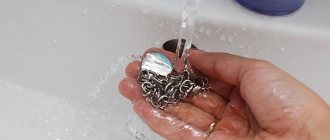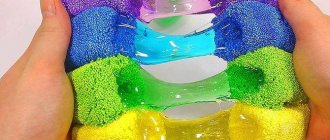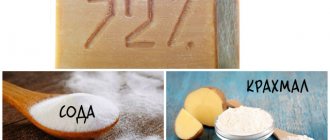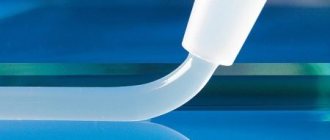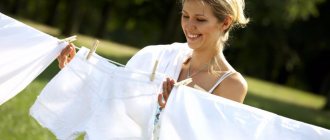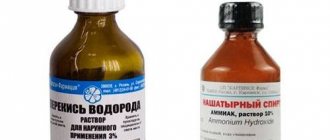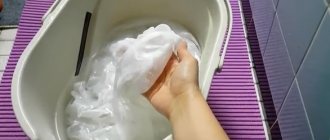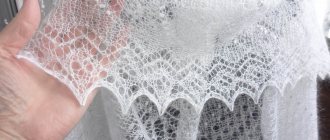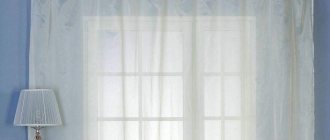Oxygen-containing
This is a new generation of bleaches.
They are able to delicately restore whiteness even without boiling, and are suitable for fabrics of any composition. There are two types of bleaches containing oxygen: in bulk form or in solution form. Their gentle formula allows you to use bleaches as an additive when washing in machines, without requiring pre-soaking. Linen that has turned yellow will become white, and colored items will restore their shade. The cost of bleaching products containing oxygen is significantly higher than chlorine-containing ones.
Store products
If you don’t trust folk remedies, using laundry bleach at home will easily remove stains and make your clothes white. You can whiten white items with bleach or bleach.
Add powder and a little bleach to the washing machine, load a white T-shirt and other clothes, select the delicate cycle. After washing, hang things out in the fresh air.
You can bleach things at home using the following bleaches:
- oxygen stain remover Astonish Oxy-Plus Stain Remover;
- Dual Power Pre-Treatment stain remover;
- Vanish Oxi Action stain remover for white clothes;
- stain remover salt Dr. Beckmann.
Ammonia
Using ammonia, you can bleach natural fabrics that have yellow or gray stains on them.
Please note: this method is not suitable for mixed or synthetic materials.
For five liters of water you need to take one tablespoon of ammonia. First, you need to treat the areas of greatest contamination, then soak the entire product in the solution for several hours. It is important to ensure that the item is completely immersed in water.
Washing bedding
Snow-white bed linen looks elegant, but care for it, like other white things, must be thorough. Over time, it becomes faded and takes on a yellowish tint. The elements included in the washing powder stain the fabric when in contact with hard water. If the laundry is stored for a long time and is in a damp room, as well as if it comes into contact with dirty things, the set may change color.
How to bleach cotton and linen bed linen? The most reliable folk remedy is boiling with the addition of ammonia and hydrogen peroxide. The procedure is as follows:
- 1Pour water into an enamel or aluminum basin and place the laundry. The latter should boil for about 40 minutes.
- 2 Dissolve 35 g of hydrogen peroxide and ammonia in a basin with laundry.
- 3Add water as it evaporates, boil for 1 hour.
Whitening a silk bedding set:
- 1It is better not to use special bleaching agents for such products. Such substances can irreparably damage the fabric.
- 2Before bleaching, the set should be washed with a delicate wash at 40 °C or by hand.
- 3Soak the laundry for several hours in a solution of hydrogen peroxide and ammonia (2 tablespoons each). To enhance the effect, you will need to add table salt.
- 4 Machine wash at a gentle temperature of no more than 30-40°C. If you decide to wash by hand, you should not wring or twist silk underwear too much.
- 5Drying silk bedding in bright sun is not recommended. If you adhere to these rules, the bedding will always be snow-white.
Whitening clothes at home is the best way
Among the many effective ways to whiten clothes, the best method among housewives is considered to be boiling, with the addition of peroxide and ammonia. For the cleaning process you will need:
- ten-liter saucepan;
- 9 liters of water;
- 50 milliliters of hydrogen peroxide (3%);
- 20 milliliters of ammonia.
Heavily washed and yellowed laundry can be bleached as follows. Place the bedding in boiling water. Boil for 30 minutes. Add half a bottle of three percent peroxide and ammonia directly to the bubbling water. The product must be constantly covered with the solution, so as the water evaporates, you need to add it. After boiling, allow the laundry to cool. Hand wash and rinse. Dry naturally.
Possibility of combination with other means
In addition to soda and hydrogen peroxide, other means are used to whiten things, which can be safely combined with the first two:
- table salt (suitable for synthetic fabrics, wool and silk);
- ammonia (cotton, linen, wool, silk, delicate fabrics);
- potassium permanganate (suitable for all types of fabric);
- mustard (suitable for all types of fabric).
You cannot add any professional bleaches (alkaline, chlorine, oxygen) to soda or hydrogen peroxide in order to enhance the effect of the former. This can lead to unforeseen consequences, such as yellowing or deterioration of the fabric.
Chlorine bleaches
A classic category of products that allows you to bleach even very faded white things at home. They are aggressive both in relation to tissues and in relation to equipment, so they should be used only in the most extreme cases.
We suggest you read: How to remove glue from suede
When using chlorine products, wear household rubber gloves and protect your eyes. Children should not be allowed near the dissolved bleach to avoid inhaling the vapors. After soaking, items should be rinsed very thoroughly to prevent skin irritation.
Precautions when working with the substance
There are certain precautions when working with peroxide to avoid tissue damage:
- The soda mixture with peroxide is applied to the fabric for no more than 5 minutes.
- Do not soak delicate materials in hot water with peroxide.
- To enhance whitening, do not add commercial bleaches.
- Do not remove rust stains with peroxide to avoid ruining your clothes.
- Use only 3% product, 10% concentrate and higher - cause skin corrosion. In case of contact with skin, rinse immediately with plenty of water. If swelling and hyperemia persist, you should consult a doctor.
- Avoid splashing peroxide on mucous membranes, mouth and eyes to avoid chemical burns.
- Wash with rubber gloves in a ventilated area.
By following these recommendations, you will avoid unpleasant consequences of work. To avoid spoiling the material, try the folk remedy on a small area.
The article has been verified by the editors
Baking soda
You can deal with things that have lost their whiteness at home without boiling. Soda not only can whiten white linen, but also helps maintain the structure of the fabric unchanged for a long time. For 1 liter of water add 1 tbsp. l. baking soda and 0.5 tbsp. l. ammonia. Linen is placed in a solution of soda and ammonia for 3 hours.
Use this method to restore the white color to baby clothes using baking soda. Soda is safe for baby's skin and does not cause allergies. Some types of stains require boiling in this solution for half an hour. The result from this method is no worse than that of chemical bleaches. In addition, things do not spoil.
How to bleach things
When it comes to caring for such a delicate item of women's wardrobe as lace lingerie, you have to resort to incredible tricks. This kind of thing wears out quickly. Sometimes it seems that it is easier to throw it away than to return it to its original snow-white appearance. However, it is not. It should be remembered that lace underwear does not like high temperatures and usually turns gray when washed in hot water. Therefore, the temperature should not exceed 40 °C.
Tips on how to bleach laundry with hydrogen peroxide:
- 1Cotton items, linen items, and synthetic fabrics are bleached in an automatic machine. Add 10-15 ml of hydrogen peroxide to 25 liters of detergent and wash for 3-5 minutes. The water should be 70-80°C.
- 2Wool and silk items are immersed in a solution consisting of 12 liters of hot water, 250 g of salt, 30 g of washing powder and 3 liters of hydrogen peroxide are added. Leave for 4 hours. Things must be washed.
- 3You can bleach gray tulle using 10 liters of water, 1 tbsp. l. ammonia and 2 tbsp. l. hydrogen peroxide. Leave for a few minutes and rinse in cold water.
Underwear, which is usually made of delicate materials such as silk, does not tolerate automatic washing. Even a gentle cycle at moderate temperatures can turn your laundry into a rag over time. If you want to keep the item in its original condition, try to wash it by hand. Tips on how to whiten underwear at home:
- 1Pour room temperature water into a basin.
- 2 Dissolve 2-3 tbsp. l. 3% hydrogen peroxide in water, stir.
- 3Immerse the underwear completely, leave for 1 hour.
- 4Wash as usual.
We suggest you familiarize yourself with How to clean a cast-iron bathtub white at home
Proper washing: useful tips
To avoid having to bleach things in ammonia, potassium permanganate, or perform any other manipulations with them, it is important to follow the washing rules:
- Do not wash white and colored laundry together.
- Wash items made from cotton or linen separately from items made from wool and synthetic fibers. If you neglect this rule, they will gradually turn from white to gray.
- When using a washing machine, use bleach powder. It will help maintain the original whiteness of things.
- Wash cotton and linen items at 60 degrees. A little table salt will create a slight whitening effect.
Method No. 1
9% white vinegar should be poured into the powder compartment and turn on the machine. The washing mode must be selected with a temperature of at least 60 degrees and an additional rinse function. During the cleaning process, vinegar can damage the walls of the drum. For a more gentle effect, many housewives recommend using some unnecessary pieces of fabric during the washing process.
You must wait until the end of the program. If the cycle is interrupted, the vinegar will remain on the machine parts and may cause damage. Usually, when cleaning with vinegar, scale actively flies off the walls.
In this regard, there is a possibility of the drain hole becoming clogged. After finishing washing, you need to clean the drain channel. At the end of the procedure, all accessible parts should be wiped with a dry cloth. To remove unpleasant odors, the machine door should be left open.
Handwash
The algorithm is as follows:
- If the items have turned yellow, soak them in soapy water before washing. To enhance the effect, use ammonia - 1 tbsp is enough. l. for 5 liters of water.
Important! It is convenient to bleach things in ammonia because it has a softening effect on water and also binds magnesium salts. They are the source of unattractive yellowness on things.
- Laundry soap also does an excellent job of removing gray stains on white fabrics. Lather the product and place it in a plastic bag. Tie it so as not to let air in and leave it for about a day. During subsequent washing, add ammonia in the same proportion.
Guide to Bleaching with Peroxide
Peroxide can be used in its pure form.
First you need to heat the water
To bleach white items with hydrogen peroxide, use only a 3% solution. More concentrated preparations corrode the skin.
What to do:
- Heat 5 liters of water to 30–35°C. If you have a large amount of clothing to bleach, increase the amount of liquid.
- Dissolve 3 teaspoons of hydrogen peroxide in it.
- Immerse items that need bleaching in this solution.
- Leave for 20–25 minutes.
- Stir the water periodically and turn the products over to get better results.
- After the allotted time has passed, take out the items, wash and rinse. Leave to dry.
If there are stains from coffee, tea, fruits, berries, or blood on clothes, pour the product onto the stained area, leave for a few minutes and wash as usual.
Advice! When washing by hand, it is better to use rubber gloves.
Method 1. aspirin
In addition to its unique abilities in medicine, aspirin is used to solve everyday problems.
If you need to whiten clothes, then acetylsalicylic acid will definitely help with this.
Mode of application:
- 12 aspirin tablets;
- 6 liters of water.
To save more time, the tablets are dissolved in 6 liters of hot water.
The amount of aspirin is calculated with the amount of water: 500 ml/1 tablet.
Clothes are soaked for 1–2 hours in the solution, after which they are rinsed in the washing machine.
The medicine gets rid of yellowness, making things white.
Sometimes washing with aspirin is carried out, tablets are added along with the powder.
Reviews:
We invite you to familiarize yourself with the rating of the best washing powders: which one to choose for washing
Olga: You buy aspirin at the pharmacy in a simple Sovdepov packaging, pure, without additives (NOT in a blister). If things are very dirty (yellow, gray...), then I put all 10 tablets per 2-3 liter, if only the socks and panties are bleached, then 2-4 tablets per half liter. Leave it overnight, you can wash it until laziness wears off. Then wash it with simple laundry soap 72%, dry it and again it’s like new. If it’s a really bad problem, then do several washes like this. Yes, the water is warm , not cold and not hot. After such experiments, you will understand that all these vanishes are advertising bullshit.
Method 2. Ammonia
Ammonia (ammonia) - an aqueous solution with a pungent odor
This product must be used with caution, as ammonia in its pure form causes burns on the skin.
Mode of application:
Mix 2 tablespoons of ammonia and 2 liters of warm water in a washing container.
Place white linen in the prepared solution and leave for a couple of hours.
After the procedure, clothes are rinsed in water.
Washing with ammonia also gives good results.
Add 2-3 spoons of solution to the wash.
When added to the machine, ammonia is poured into the conditioner compartment.
Reviews:
Ejuska:
Fading things happen to everyone, it’s just a disaster - a random black sock in colored underwear and that’s it, screw the underwear) I tried many methods, because I only have shorts lying around - nothing took them, I didn’t try to get this mob out of them .
And then they advised me to use ammonia. I decided that it couldn’t get any worse; as a last resort, I’d throw it away! I didn't have to throw it away)
There are two ways to use:
1. For 5 liters of boiling water and one or two things, add one or two bottles of ammonia and soak for an hour or two, periodically you can refresh the water and ammonia (if it has faded a long time ago or is very scary)). Be sure to use boiling water!
2. for 5l. water 1-2 bottles of ammonia and boil the item in this solution for an hour. You can have two, but I got it all out in an hour)
After the procedure, quickly wash with soap or water with your hands or rinse in a machine, as the item will smell and the smell will have to be eliminated)
I warn you, it’s better to do it in a separate room, with the door closed and the window open, because the stench will be simply hellish! You can probably add more bubbles, but you won’t survive the smell)))
Let's go in order.
Laundry
1. An excellent product for removing stains from white laundry. Before washing, it is enough to apply a little peroxide to the stain and leave it for 5-10 minutes, then rub lightly and you can wash as usual.
2. Gentle bleaching of bed linen, terry towels, baby diapers. Just add 50-100 ml with each wash. (depending on the load of the washing machine) into the washing powder compartment. It will not only help to carefully bleach the fabric, but also disinfect it. At the same time, there will be no unpleasant smell of bleach from the laundry.
3. Separately, we mention washing tulle curtains. Before washing, soak them in cold water with hydrogen peroxide for 30 minutes, then rinse and add it to the conditioner compartment of the washing machine. You will be surprised at the whiteness and freshness of the tulle after washing.
Cleaning the apartment.
4. As already mentioned, peroxide does an excellent job of removing foreign odors, but also disinfects. Therefore, add it to the water for washing the floor. Then the floor will shine, there will be no streaks and “stickiness”, like from store-bought floor cleaners.
5. In the kitchen, peroxide will help to scrub off faded countertops and kitchen facades.
6. Peroxide will have the same effect when cleaning the bathroom. Wipe tiles or wall panels, use to wash plumbing fixtures (especially shower stalls). Apply peroxide to the surfaces using a spray bottle, leave for 10 minutes and wipe dry. It will not only help clean, but will fight fungus in tile seams, joints, and hard-to-reach places. And the air in the room will be much fresher after such cleaning.
7. This product should not be neglected when cleaning upholstered furniture. Again, we will remove the unpleasant odor and refresh the color of the upholstery.
8. Treat your children’s toys with a solution of hydrogen peroxide. Wherever they go, and then the baby puts them in his mouth... Disinfect them.
9. Use peroxide to clean cat litter boxes and trash cans. Peroxide will perfectly remove unpleasant odors.
10. Dilute peroxide (25 ml per 1 liter of water) and spray or wipe the leaves of house plants. This procedure will strengthen the plant’s immunity and protect them from fungi and pests. plants will delight you with fresh greenery and will better absorb carbon dioxide in the apartment. This treatment is especially useful in winter.
11. We also recommend regularly soaking toothbrushes for 15-20 minutes in a peroxide solution.
In the kitchen.
12. Disinfect cutting boards with hydrogen peroxide, because microcracks on their surface can contain many pathogenic putrefactive bacteria. Powder and gel products cannot cope with this task, because due to their thick consistency they do not penetrate into microcracks...
13. The same should be done regularly with the bread box. The bread will be stored longer and will not have an unpleasant sour smell.
14. Peroxide will also become an indispensable means for cleaning the refrigerator. Again, it removes odors, fights mold and bacteria, which will not only tidy up your refrigerator, but also after such treatment, the food in it will be able to be stored longer.
Other household items.
15. Wash shoe insoles with peroxide added. This will get rid of the unpleasant odor and protect against the formation of fungus on the feet.
For self-care.
16. Hydrogen peroxide is great for cleaning pores on oily skin. We recommend wiping your face with a cotton swab dipped in this solution 1-2 times a week.
17. Rinsing your mouth after brushing your teeth will not only help whiten your teeth, but also get rid of bad breath.
18. Rinse your hair after washing with a peroxide solution (30 ml per 1 liter of warm water). Your hair will become voluminous and shiny.
19. Regularly take foot baths with peroxide. It works great against foot fungus.
20. If you do not have the opportunity to take a shower (for example, you are on the road, on a train). Wipe your armpits and other places where sweat glands accumulate with a cotton swab dipped in hydrogen peroxide. This will instantly relieve you of the unpleasant odor of sweat and give you a feeling of freshness. By the way, for such needs, the bottle with peroxide is often equipped with a sprayer. Ask at the pharmacy.
So we looked at 20 simple and effective ways to use hydrogen peroxide in our daily lives. It would seem like a simple, inexpensive and available remedy at any pharmacy, but how many benefits!
We suggest you familiarize yourself with How to remove wax from clothes
Do you want to see more housekeeping tips, unusual and simple cooking recipes, recommendations for self-care, and improving your quality of life in your feed?
Method 3: hydrogen peroxide
Hydrogen peroxide also showed a whitening effect.
If you add ammonia to the peroxide, the result will be more noticeable.
Mode of application:
For 5 liters of water use 2 tbsp. spoons of alcohol and 2 tbsp. spoons of peroxide.
Place the water on the fire and heat it, but do not bring it to a boil.
White things are placed in the finished mixture.
Stir the clothes a couple of times and then rinse them in cool water.
For woolen items, you should not bleach laundry with hydrogen peroxide, as the size of the items may decrease.
Reviews:
Valentine:
You need to pour a teaspoon of washing powder or soda ash into a bottle of peroxide and mix well. I have a jar of this solution in my bathroom, I pour it on the stain (I bought peroxide in a plastic bottle with a spout, it’s very convenient) and leave the laundry for an hour, then wash it in the washing machine. The peroxide forms foam on the stain, which pushes out the dirt from the fabric, when it interacts with the stain, oxygen is formed, which helps remove the stain, and soda ash enhances the effect. Very effective and cheap, a good alternative to all kinds of expensive stain removers.
We invite you to familiarize yourself with 15 remedies for sweaty feet - what to do when your feet sweat?
Advantages
- visibly whitens
- inexpensive and effective
Rules for using baking soda and hydrogen peroxide for whitening
These products are considered gentle and suitable for bleaching items made from various fabrics.
Bleaching of cotton and linen products
The simplest way to bleach cotton items is to soak them in a solution of hydrogen peroxide. To do this you need:
- Wash items using powder.
- Dilute 1 tsp. peroxide in 2 liters of warm water.
- Soak the items in this liquid for 20 minutes, turning the items over every 5 minutes.
- After soaking, items should be rinsed thoroughly. No re-washing required.
Cotton fabrics can be boiled for an additional 30 minutes. This should be done as follows:
- Soak clothes or linen in a soda solution (6–7 tablespoons per 7 liters of water at 40°C).
- Then place in a large enamel bowl, add water (5 liters of water per 1 kg of laundry) and add washing powder.
- Boil for 30 minutes, stirring occasionally or turning things over with tongs.
Only cotton products can be boiled
You can remove traces of sweat with hydrogen peroxide only on cotton products. To do this you need:
- Apply hydrogen peroxide to the stain.
- Wait 3–5 minutes.
- Rinse in cool water.
- If necessary, repeat after the product has dried.
For linen products, it is better to use soda ash. It effectively fights yellow spots from sweat:
- Pour soda ash (1 tbsp for a full load) into the powder tray of the washing machine. At the same time, you cannot add other laundry detergents, especially bleaching agents.
- Set the washing mode to 70° followed by rinsing.
- Repeat washing with regular powder.
Bleaching of synthetic fabrics
Synthetic fabrics can only be bleached at low temperatures. A mixture of soda and ammonia is effective:
- Mix 2 tbsp in 10 liters of water. l. ammonia, 10 tbsp. l. soda
- Soak the laundry in this mixture for 3 hours.
- After this time, rinse the items and then wash them.
If the cause of the graying of synthetic fabric was careless washing, it is unlikely that it will be possible to revive such a product. In addition to the fact that such products change color, pellets also form on the surface, which generally spoils the appearance of the product.
You can remove yellow stains that appeared as a result of washing in water with rust from synthetic products as follows:
- Mix 10 liters of water and 200 ml of hydrogen peroxide.
- Soak damaged items in this mixture for 2 hours.
- After this, rinse and wash in clean water. It must be remembered that synthetic products cannot be wrung out after bleaching and dried in direct sunlight.
A mixture of hydrogen peroxide and soda ash will also help to bleach synthetic products:
- Pour 10 liters of water at a temperature of 30° into a plastic container.
- Add 30 ml of hydrogen peroxide and 2 tbsp. l. soda ash.
- Soak clothes for 20–30 minutes, then rinse and wash.
Bleaching of wool and silk products
Wool and silk are fabrics of animal origin. The peculiarity of bleaching these fabrics is that when bleaching and rinsing the products, you need to use water at the same temperature.
Hydrogen peroxide is also an effective stain remover when bleaching wool or silk clothes. The whitening instructions are as follows:
- Fill a 10-liter bucket halfway with water.
- Dilute 1 tbsp in it. l. powder for white delicate products, 4 tbsp. l. table salt, 1 tbsp. l. hydrogen peroxide and ammonia.
- Soak items with yellow stains in this solution for two hours.
- Rinse the items in cold water, then add vinegar (1/4 cup per 5 liters of warm water) and wash.
Woolen items can be soaked in a soda solution before each wash. Add 50 g of soda to 5 liters of water. Soaking duration is 15–20 minutes.
You can bleach wool products using only hydrogen peroxide, but you will need a large amount of it:
- You need to mix hydrogen peroxide with cool water in a ratio of 1:8.
- You need to soak things in this solution for 5–7 hours (you can leave them overnight, the product will not be damaged).
- Remove items from the solution (no additional rinsing is required) and dry in fresh air, but away from direct sunlight.
Universal means
There are several ways to use baking soda to whiten whites. The first involves the use of soda and ammonia:
- First prepare a solution by mixing 5 liters of water, 5 tbsp. l. baking soda and 2 tbsp. l. ammonia.
- Soak grayed items in this solution for 3–4 hours.
- Wash items by hand or in a washing machine, or simply rinse with cool water. The whitening effect will be in both the first and second cases.
White clothes turn gray from frequent washing
If there are yellow spots on clothes, you can use soda paste:
- Dilute baking soda in water to obtain a paste-like mixture.
- Apply this mixture to the stains, rubbing it in as hard as possible with your fingers.
If you need to remove faded stains from white things, it is recommended to use soda paste rather than a solution. - Leave for 30 minutes.
- Clean the paste from the surface of the product.
- Wash the item using powder. After drying, repeat if necessary.
I often use the last recipe to whiten the cuffs of my daughter’s blouse. The item itself is black, but its cuffs are white, which is why it has to be washed more often. I couldn’t get the blouse (or rather, the white part of it) to soak, so I reduced the amount of water. Mix soda, ammonia and a little water until you get a paste. I smeared it on the cuffs and left it for an hour. Then rinsed thoroughly. I won’t say that the cuffs have become crystal white, but they are no longer gray. I don’t risk using the product often, in case the fabric gets damaged.
To bleach gray fabric (the method is suitable even for delicate fabrics) with hydrogen peroxide, you need to follow the instructions:
- Pour hot water into a large container. If it is silk or wool, then the water temperature should not exceed 40°.
- Add 2 tbsp. l. hydrogen peroxide and ammonia for every 10 liters of water.
- Soak the damaged item in the resulting solution for 30 minutes.
- Wash the item in the usual way, using a powder suitable for this type of fabric.
Video: washing underwear
Ways to restore the color of a faded item
When restoring the color of a white item, it is important to immediately take action. The product should be washed again with a large amount of white powder with the addition of a small amount of soda ash. If this measure did not give a positive result, or if the problem was not detected immediately, then the following methods can be used:
- digestion with ammonia and hydrogen peroxide - the method is used to restore the color of bed linen and other cotton products (add 15 ml of ammonia and 200 ml of hydrogen peroxide to 10 liters of water, the mixture can be used for cotton fabrics);
- applying soda paste to dense fabrics (mix soda with water to form a paste, apply to problem areas and leave for 20 minutes, then wash the product);
- soaking in a solution of hydrogen peroxide and washing powder - the method is effective for delicate fabrics (add hydrogen peroxide in a ratio of 1:10 to water, and then add 25 g of washing powder, soak the items in the liquid for 2-3 hours, then rinse the items) ;
- bleaching with a mixture of ammonia (5 tbsp), hydrogen peroxide (2 tbsp), a strong solution of laundry soap (grate 1 bar of soap and dissolve in 0.5 liters of water) - this way you can bleach synthetic items (the resulting dissolve the mixture in 10 liters of water, then soak the damaged items in the solution for 30–35 minutes, and then rinse)
Method 5. baking soda
The method of bleaching things with soda is easy to use and accessible to everyone.
It will eliminate yellowness of linen and stubborn stains.
Mode of application:
- Add soda when boiling laundry - in this case, you will have to boil things for at least 30 minutes.
- Soaking: for 5 liters of water you need 5 tbsp. spoons of soda and 2 tbsp. spoons of ammonia. Place the item in this solution for 2 hours. Then wash as usual.
- Add 2-3 tbsp. spoons of soda along with powder when washing in a machine.
Reviews:
Unusual19:
CLEANING everything!))
Soda perfectly cleans white coffee mugs, pans, forks and spoons.
In addition, it helps to make shoes snow-white: especially sneakers. Apply baking soda to a sponge and rub
Have a great mood everyone)
Advantages
- 100% effective
- harmless to health
- always at hand
- cheap
- inexpensive
- very versatile
- effectiveness
According to reviews, among folk bleaching agents, soda is in first place, with a slight difference in second place - ammonia, peroxide, aspirin, in third - boric acid
Method for removing yellow stains from white shirts
Very often, owners of white blouses and shirts are faced with the appearance of yellow stains from sweat and marks left by deodorants. Such pollution is striking and looks unaesthetic and repulsive. Fresh stains on white shirts can be removed by washing with regular detergent. But with things that have been lying around for several days, the situation is different.
You need to prepare a bleaching solution:
- heat 4 liters of water to 60–70°C.
- add 2 tbsp. spoons of all-purpose soda ash;
- dilute 2 teaspoons of hydrogen peroxide.
All-purpose soda ash will help whiten a white shirt.
Dip the shirt into the solution for a quarter of an hour, rinse, and dry on hangers.
The juice of 1/2 lemon and a teaspoon of peroxide will help remove yellowness on a synthetic blouse. Use a sponge soaked in this solution to go over the areas of contamination. Or wash the necessary areas with the resulting composition.
If you don’t like the proposed methods, then pay attention to an effective bleach from Aliexpress.
How to whiten white things at home - folk remedies
Whitening products depend on the item you want to restore its whiteness. Particular attention should be paid to:
- Lace and regular underwear. You need to wash yellowish underwear by hand and in warm water so as not to damage the thin fabric. The best whitening agent is hydrogen peroxide. You cannot boil the product; the fibers will lose their structure and you will simply throw away the laundry.
- Items that were accidentally dyed during general washing. Antilin detergent will help whiten items made of synthetic fabric; for natural materials, you can use boiling in a solution of water and hydrogen peroxide (dissolve 2 tablespoons of peroxide in 5 liters of water, boil the item for 30 minutes).
- Clothes made from polyester. Most modern things are made from synthetic fabric, so it’s worth remembering that:
- it cannot be bleached at high temperatures;
- Do not use products containing chlorine;
- Dry after bleaching in a washing machine.
- Bleaching things with colored prints is the most difficult case for a housewife. It is impossible to completely soak things. Therefore, apply any of the available stain removers or ordinary laundry soap to the contaminated areas, and leave to soak for a couple of hours. Then carefully wash the item.
https://www.youtube.com/watch?v=JnEUpbjwdJE
For all other things in your wardrobe, such as white T-shirts, trousers, blouses, use folk remedies that our grandmothers used.
The effectiveness of baking soda and hydrogen peroxide in bleaching fabrics
Frequent use of many professional bleaches leads to rapid wear of fabric. Hydrogen peroxide and soda are effective folk bleaches, but they do not destroy the structure of the fibers. But they can only be used if the fabric is not stretched, not worn, and has intact fibers. In this case, the use of soda and hydrogen peroxide is pointless. It is better to get rid of such a product, or it can be repainted in a different color with acrylic or powder dyes.
Baking soda and hydrogen peroxide are great for whitening things without ruining them.
Baking soda and hydrogen peroxide can be used for many fabrics, including delicate ones:
- flax (for bleaching it is better to choose soda ash);
- cotton (the least capricious material that can withstand even the most aggressive treatments);
- synthetic material (products cannot be washed at high water temperatures, above 40°, and soda and hydrogen peroxide cannot be used in their pure form, although hydrogen peroxide can be combined with soda ash);
- silk and wool (use soda to bleach these fabrics with caution, in particular, the solution should not be strong, no more than 2%, and you can also use only food grade soda, soda ash is not suitable for fabrics of animal origin, you can use water no warmer than 40° , and after processing the fabric, it must be thoroughly rinsed, first in plain water, and then with the addition of vinegar).
These products can also be used for whitening and underwear. To sew these products, delicate fabrics are used, which may lose their properties when washed in a machine.
Baking soda and hydrogen peroxide can rid fabric of grayness, yellow stains and faded stains, and they can be used simultaneously.
